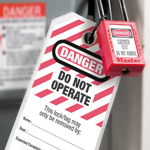Title Page
-
Facility
-
Location (Room Number)
-
Date Created:
-
Equipment Name and/or number:
-
Prepared by
-
Purpose:
-
Visual Reference of equipment
ENERGY SOURCES
-
Energy Source
- Electrical
- Mechanical
- Pressurized Liquids and Gases
- Hydraulic
- Pneumatic
- Chemical
- Thermal
- Gravity
- Other
-
Other Energy Source:
-
Location of Isolation
-
Lockout Device and Method
-
Dissipation and Verification
SEQUENCE of LOCKOUT/TAGOUT
SEQUENCE OF LOCKOUT
-
Purpose This procedure establishes the minimum requirements for the lockout of energy isolating devices whenever maintenance or servicing is done on machines or equipment. It shall be used to ensure that the machine or equipment is stopped, isolated from all potentially hazardous energy sources and locked out before employees perform any servicing or maintenance where the unexpected energization or startup of the machine or equipment or release of stored energy could cause injury. Compliance With This Program All employees are required to comply with the restrictions and limitations imposed upon them during the use of lockout. The authorized employees are required to perform the lockout in accordance with this procedure. All employees, upon observing a machine or piece of equipment which is locked out to perform servicing or maintenance shall not attempt to start, energize, or use that machine or equipment
-
Notify Affected Workers
-
(1) Notify all affected employees that servicing or maintenance is required on a machine or equipment and that the machine or equipment must be shut down and locked out to perform the servicing or maintenance
-
Review Procedures
-
(2) The authorized employee shall refer to the company procedure to identify the type and magnitude of the energy that the machine or equipment utilizes, shall understand the hazards of the energy, and shall know the methods to control the energy
-
Stop Machine
-
(3) If the machine or equipment is operating, shut it down by the normal stopping procedure (depress the stop button, open switch, close valve, etc.).
-
Isolate Energy
-
(4) De-activate the energy isolating device(s) so that the machine or equipment is isolated from the energy source(s).
-
Lockout Energy
-
(5) Lock out the energy isolating device(s) with assigned individual lock(s).
-
Dissipate Energy
-
(6) Stored or residual energy (such as that in capacitors, springs, elevated machine members, rotating flywheels, hydraulic systems, and air, gas, steam, or water pressure, etc.) must be dissipated or restrained by methods such as grounding, repositioning, blocking, bleeding down, etc.
-
Verify
-
(7) Ensure that the equipment is disconnected from the energy source(s) by first checking that no personnel are exposed, then verify the isolation of the equipment by operating the push button or other normal operating control(s) or by testing to make certain the equipment will not operate. CAUTION: Return operating control(s) to neutral or "off" position after verifying the isolation of the equipment.
-
Locked and Tagged out
-
(8) The machine or equipment is now locked out.
RESTORE to SERVICE SEQUENCE
RESTORING EQUIPMENT TO SERVICE. When the servicing or maintenance is completed and the machine or equipment is ready to return to normal operating condition, the following steps shall be taken
-
Check Machine
-
(1) Check the machine or equipment and the immediate area around the machine to ensure that nonessential items have been removed and that the machine or equipment components are operationally intact. WARNING: Ensure all guards are in place
-
Check Work Area
-
(2) Check the work area to ensure that all employees have been safely positioned or removed from the area
-
Verify
-
(3) Verify that the controls are in neutral
-
Remove lockout
-
(4) Remove the lockout devices and reenergize the machine or equipment
-
Notify
-
(5) Notify affected employees that the servicing or maintenance is completed and the machine or equipment is ready for use
-
Reference: OSHA 29 CFR 1910.147, Appendix A Typical minimal lockout procedures https://www.osha.gov/laws-regs/regulations/standardnumber/1910/1910.147AppA
-
Signature:
-
Date:










